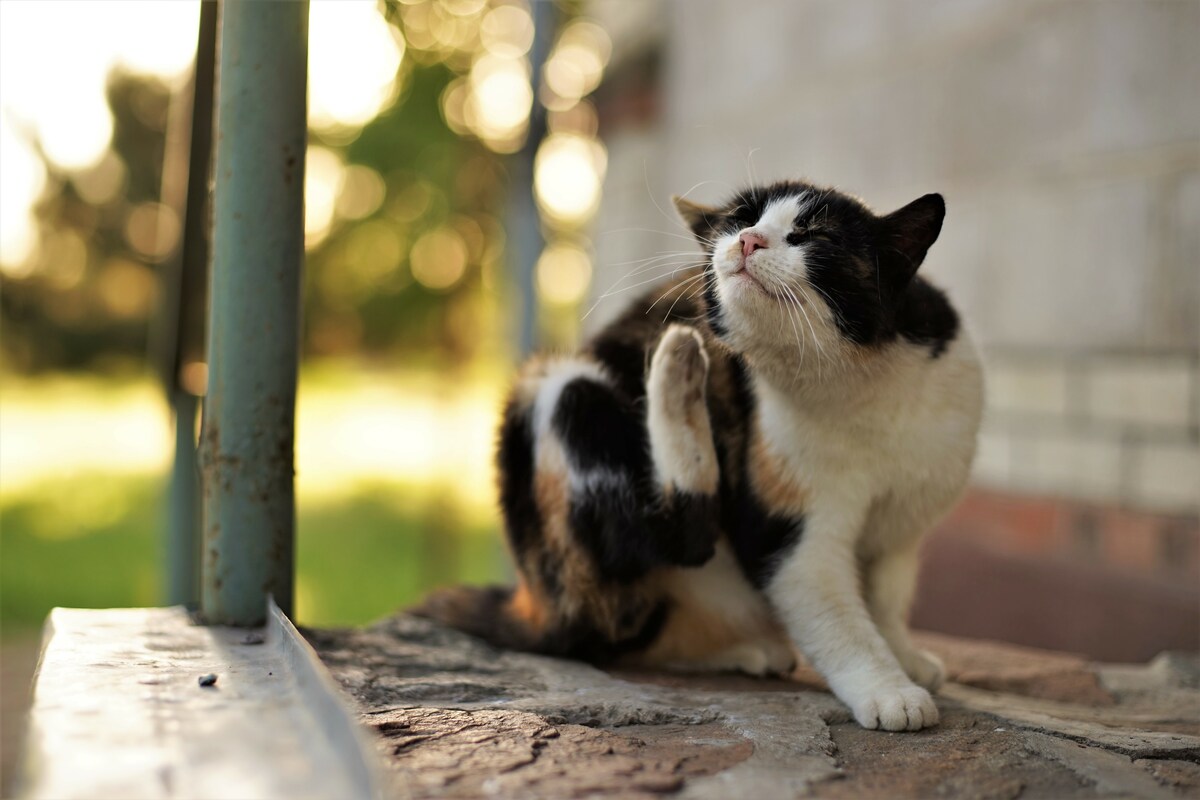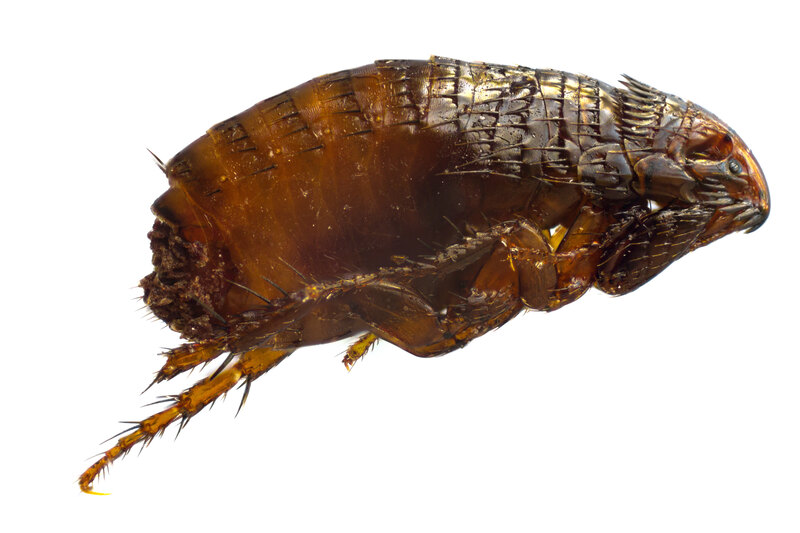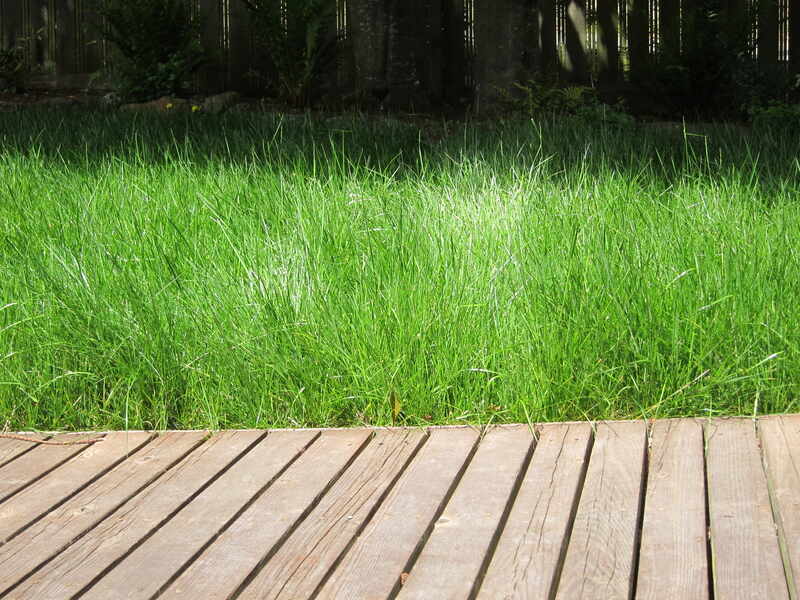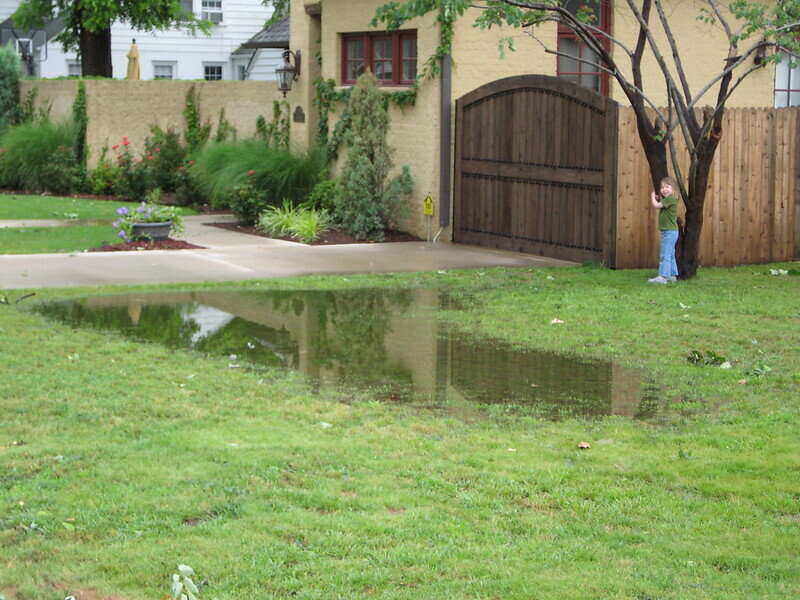
Standing water, shady and humid hiding spots and available food are what attract fleas to your yard along with the animals that carry them – stray cats and dogs and wildlife.
Fleas are tiny, wingless parasites that live in yard debris and jump on pets and humans to feed on their blood. They cause itching and irritation, carry dangerous diseases, and – trust me when I say – they can infest your home so fast you won’t believe it. Get ahead of these nasty pests and clear out all the flea-friendly spots in your yard.
Rodents and Pests

Fleas don’t walk in your yard on their own, their eggs are brought in by wildlife and stray cats and dogs.
There are an estimated 2,500 species of fleas in the world, of which about 325 are present in the United States. The most common are cat fleas and dog fleas (Ctenocephalides felis and Ctenocephalides canis). Despite their names, these two types of fleas don’t infest only cats and dogs. A study published in Parasites & Vectors shows that over 130 wildlife species harbor these flea species.
Rodents, foxes, raccoons, opossums, skunks, rabbits, and coyotes are potential hosts, while feral cats and dogs are the most often infested. If you spotted some strays around your property, they might be the reason you have fleas in your yard.
Michael Dryden, professor of Veterinary Parasitology at Kansas State University, compares infested animals with live salt shakers. “As these animals move through the neighborhood and yards, flea eggs are dropping off,” says Dr. Dryden.
A single female flea can lay up to 50 eggs daily, so a small flea problem can quickly become an infestation and a nightmare for pet owners.
My tip: If you notice signs of fleas, walk around the yard and look for any damage that might indicate a critter has moved on your property.
Tall Grass and Plenty of Hiding Spots

Flea larvae are sensitive to high heat, wind, and dryness, so they hide under yard clutter to seek shade and moisture.
Yard waste, long grass, and other neglected areas play a double role in supporting flea infestations.
- They attract wildlife by providing suitable shelter.
- They increase the flea larvae’ chances of survival.
Flea larvae dry out very quickly unless they find a humid, shady area.
“Because of their susceptibility to heat and desiccation, flea larvae are not likely to survive outdoors in shade-free areas,” says Dr. Dryden.
The best spots in a yard for fleas to survive and reach maturity include:
- Leaf litter and other yard waste
- Overgrown grass and shrubs
- Dense ground covers, such as thick mulch
- Wood piles
- Old furniture or other debris in your backyard
- Dead vegetation under porches and decks
- Crawl spaces
To prevent fleas from infesting your yard, keep it clean of all organic debris, mow it regularly, prune the shrubs and trees, and grow flea-repellent plants in areas that can shelter wildlife and fleas (e.g. around the crawl space).
Standing Water and Moisture

Standing water creates drinking areas for wildlife that might carry fleas, attracting them to your yard.
Common sources of water that attract wild animals and insects in yards include:
- Puddles in low spots or around leaky hoses
- Bird baths
- Pet bowls
- Saucers under flower pots
- Kiddie pools
- Buckets and tires that collect rainwater
To keep fleas (and mosquitoes) at bay, level the lawn, repair leaky hoses, and get rid of objects that can hold water.
Overwatered lawns can attract fleas, but they are not the best habitat for their development. Here’s why:
- Rain and irrigation can drown the flea larvae if the soil is compacted and cannot absorb the water quickly.
- Irrigation also washes away the adult fecal blood (that dark brown dirt, like ground pepper, that fleas leave behind) the larvae need to survive.
Available Food
If you feed the wild animals, they’ll feed the fleas.
Many wildlife pests that roam through your yard feed on vegetation. You can’t remove all of it to keep the critters away, but you can ensure you don’t leave extra snacks around the yard.
Food sources that can attract flea-carrying animals include:
- Fallen fruits left on the ground
- Seeds that fell on the soil from bird feeders
- Plant or grass seeds easy to access in garden sheds
- Dog or cat food placed outside
- Food waste left on the lawn after a barbecue
- Garbage has fallen out of the bins and unsealed garbage bins.
Do your best to keep the yard free of organic debris in summer and fall, when the flea population increases rapidly, and the risk of a heavy infestation is higher.
What do fleas feed on? Adult fleas feed only on blood and, though, require a warm-blooded host to survive and reproduce. It can be a wild animal, your pet, or your ankle. The more pets you have that spend time outdoors, the more attractive your yard is for fleas.
My Tip: While you’re tackling the yard infestation, protect your pets with flea and tick pills, collars, or liquid medication (talk to the veterinarian first). Last fall, it did wonders for our cats, Mira and Poxy. Otherwise, the pets can very easily take on any remaining fleas.
The flea larvae must eat flea dirt and flea eggs to develop into pupae and then into adults. These droppings are highly available in animal nests and places in the yard where hosts, including your furry friends, spend a lot of time. Start with those areas when treating for fleas.
FAQ
A sudden infestation of fleas is often caused by an increase in temperature and humidity and an abundance of food, such as warm-blooded animals in your yard, either pets or wildlife.
You know fleas are in your yard when you spot them on your ankles or white socks, and your pet scratches a lot and is more nervous than usual. Fleas also gather on the forehead of cats and dogs and are easily spotted on animals with light-color fur.
To get rid of fleas in your yard:
• Mow tall grass and trim shrubs
• Remove all yard debris
• Evict wildlife pests
• Use natural treatments such as beneficial nematodes or diatomaceous earth
• Install flea traps in small spaces
• Consider insecticides and a professional flea treatment
Fleas are attracted by the carbon dioxide emitted by warm-blooded hosts. They use it to find their next blood meal, as they also use heat and movement perceived in the light to find their prey.
Keep a Flea-Proof Yard!
Protect your pets from nasty flea bites and the health problems they can cause. Find a pest control professional with LawnStarter and get a flea-free yard right now!
LawnStarter pros can also help you keep the yard clean, the lawn mowed and the shrubs trimmed so fleas don’t find shelter on your property.
Sources:
- Michigan State University Extension (2007, May) Fleas. https://www.canr.msu.edu/ipm/uploads/files/fleas.pdf
- Clark, N.J., Seddon, J.M., Šlapeta, J. et al. Parasite spread at the domestic animal – wildlife interface: anthropogenic habitat use, phylogeny and body mass drive risk of cat and dog flea (Ctenocephalides spp.) infestation in wild mammals. Parasites Vectors 11, 8 (2018). https://doi.org/10.1186/s13071-017-2564-z
- Dryden, M. (1993, January). Biology of fleas of dogs and cats. https://www.researchgate.net/publication/285075916_Biology_of_fleas_of_dogs_and_cats
- Kern W.H. Jr, Koehler P.G., Patterson R.S. (1992, March). Diel patterns of cat flea (Siphonaptera: Pulicidae) egg and fecal deposition. J Med Entomol. 1992 Mar;29(2):203-6. doi: 10.1093/jmedent/29.2.203. PMID: 1495030.
- Dryden, M. (2010). Flea Control Challenges: How Your Clients Can Win the Battle. Understanding and controlling fleas in the “red-line” home. https://drmichaeldryden.com/file_download/8
Main Image Credit: Omega / Adobe Stock Free / License